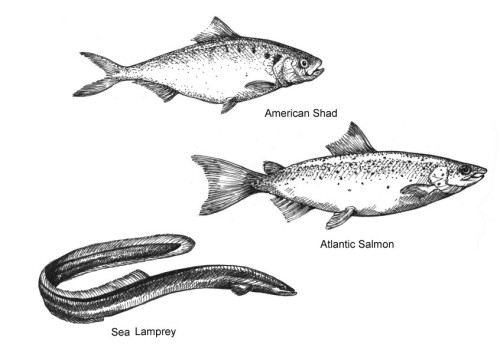
Fifty years ago, the Connecticut River was called the best-landscaped sewer in New England. The river could not support aquatic life, and people could not use it to boat, swim, or fish. But since the passage of the Clean Water Act in 1972, the major direct sources of pollution have been reduced, and the river has taken on renewed life. Thanks to this cleanup, we have been able to start restoring anadromous fish to the Connecticut River.
Anadromous fish are all those that return from salt water to fresh water in order to spawn. In the Connecticut, the primary anadromous species are the American shad, the gizzard shad, the blueback herring, the alewife, and – the poster child - the Atlantic salmon. When dams were built across the Connecticut River for power, logging, and transportation, beginning in the 1800s, these species were inadvertently fenced out of the upper river.
The effort to restore anadromous fish runs to the Connecticut River began in earnest two decades ago. Since the start of the restoration program, the first five dams upriver from Long Island Sound have been modified to allow fish to swim by. There is now a “fish lift” elevator at the dam in Holyoke, Massachusetts, and fish ladders at the dams at Turners Falls, Massachusetts, and at the Vernon, Bellows Falls, and Wilder dams between New Hampshire and Vermont.
Abandoned dams on the smaller tributaries of the Connecticut are also being removed to give migrating fish (both anadromous and resident) access to their preferred spawning habitat. These smaller dams cause water temperature to increase and dissolved oxygen to decrease, making life difficult or impossible for fish and other aquatic species. Many of these dams no longer provide economic benefits yet still do environmental harm, so their removal is a top priority of the restoration program.
The dam at Holyoke, Massachusetts, is where the official fish counting and tagging takes place these days. Holyoke is the first dam on the Connecticut upriver from Long Island Sound (Windsor Locks in Connecticut was breached more than 20 years ago). Forty-seven Atlantic salmon made it over Holyoke in 2003. But salmon are not the only anadromous fish returning to their historic range. This year, 288,000 American shad also made it up the Connecticut River past the dam at Holyoke, along with more than 1,300 blueback herring and 850 gizzard shad.
Shad numbers have increased more than thirtyfold since the restoration program began, in part because shad were never wiped out in the lower reaches of the river. Shad lay their eggs in the river’s main channel, and hence a population, albeit reduced, has always lived below the first dam. These native fish ascended the fish ladders and returned to the upper river as soon as they were given the chance.
Salmon, on the other hand, lay their eggs only in the rocky shallows of the upper river and its tributaries. When dams blocked their access to these areas, they were extirpated from the river. New salmon had to be brought in from Maine at the start of the restoration program, and because the Connecticut is the southernmost river in the Atlantic Salmon’s habitat, it will take time for the Maine genetic stock to become acquainted with the new surroundings.
Also making the trip over the Holyoke dam this year were some 54,000 sea lamprey – a species no one likes to talk about. Sea lamprey do not harm fish in the Connecticut River, however, because, like all true anadromous fish, they do not feed once they return to fresh water. But lamprey have developed a sinister reputation over in Lake Champlain, where they were introduced by humans. The lamprey in Lake Champlain are no longer returning to the sea and are, instead, staying in the lake to feed and grow. They have become a landlocked species and now feed heavily on other fish species in the lake.
Back on the Connecticut, of the salmon tagged and released at the Holyoke Dam in 2003, one, it seems, was simply a fish in need of directions. After this particular salmon was tagged and identified in Massachusetts, it was later found back down river at the Rainbow Dam Fishway in Barkhamsted, Connecticut. This fish apparently overshot the Farmington River on its way up the Connecticut, was tagged and released at Holyoke, discovered its ‘mistake’, dropped back down over the Holyoke Dam and downriver to Connecticut, re-entered the Farmington River, and ascended the Rainbow Fishway on its way to its natal spawning area.
As if swimming upstream weren’t enough of a challenge by itself!

